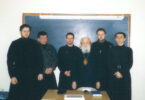Schema-Archimandrite Theophan (Shishmanov) passed away on this day in 1987.
At the end of October, I presented at the Byzantine Studies Association of North America conference in Vancouver. My paper was on the notion of supreme theological authority according to St. Theodore the Studite. Having presented this paper, I realized that the research on the subject was sufficient for a presentation but not for a final publication, so I cleared it away from my “mental desktop” and “closed the case.” However, a takeaway from working on this project was that I realized how St. Theodore’s spirit of “living the Gospel to the uttermost” (pros tin akribein tou Evangleion) lives on in Holy Trinity Monastery in Jordanville.
I am writing now about a contemporary man who followed the desert fathers’ steps. Archimandrite Theophan belonged to the first generation of Russian émigré youth, which succeeded the bishops, monastics, military, and other clergy who left Russia as part of the exodus. He was born in 1901 in Crimea. The future Archimandrite Theophan studied at the Russian gymnasium in Zagreb and joined the Russian brotherhood of the monastery in Milkovo. Because of the abbot, Archimandrite Ambrose (Kurganov), the brotherhood, and its father-confessor schema-hieromonk Mark (Arkhipov) attracted many Russian youth looking for monastic paths. Mikhail Maksimovich (the future St. John of Shanghai and San Francisco), the future Archimandrite Kiprian (Kern), Bishop Philip (von Gardner), Archbishops Anthony (Medvedev) of San Francisco and Anthony (Sinkevich) of Los Angeles began their monastic path there. The Serbian Elder Fr. Thaddeus (Strabulovich) of Vitovnica was a novice there and learned the Jesus Prayer from Fr. Ambrose, who had lived in Optina Hermitage.
In 1930, Metropolitan Anthony (Khrapovitskii) tonsured the young man (I don’t know his baptismal name) a monk. In 1933, Fr. Ambrose reposed, and Fr. Luke (Rodionov) became abbot. I understand that it must have been tough for a young abbot (b. 1901) to fill the shoes of an elder. In 1933, Serbian church authorities moved Fr. Luke to be the abbot of the Tuman Monastery, where in 1941, the brothers and future bishops Antony and Leonty (Bartoshevich) were tonsured monks. Fr. Luke went there with Russian brethren, including Fr. Theophan. On August 22, I wrote about Russian priests killed in Braničevo diocese during World War II. The 14th-century Tuman Monastery belonged to the same diocese. To be safe, Frs. Luke, Theophan, and others moved into a private house in Zemun, a suburb of Belgrade. The nuns from Nimnik Convent in the same diocese also moved to Zemun. After World War II, Fr. Luke organized the Brotherhood of the Holy Cross out of these monastics.
The brotherhood joined the Moscow Patriarchate. By 1950, the Tito government had expelled most Russians, including Lesna Convent and the Brotherhood of the Holy Cross, from the Socialist Federative Republic of Yugoslavia.
Fr. Luke (Rodionov) and Fr. Theophan arrived in America. They settled in Nebraska, where Fr. Theophan worked at a hospital. The events of war and exile took a toll on Fr. Luke. He abandoned monasticism and married. This is what I meant at the beginning of this report when saying that what I am writing is like a story from the Paterikon: despite the drastic change in circumstances, Fr. Theophan continued to consider Fr. Luke his abbot and stayed with him until the latter sent him away.
After this, in the 1950s Chicago, Fr. Theophan became a cell attendant for Archbishop Seraphim (Ivanov), who was the abbot of St. Job of Pochaev monastery in Ladomirová, Slovakia. Archbishop Seraphim did not have an easy personality. After his retirement, Vladyka Seraphim moved to the New Kursk-Root Icon Hermitage in Mahopac, NY, with Fr. Theophan in tow. In July of 1987, Archbishop Seraphim passed away, as did Fr. Theophan four months later.
Source:
V.A. Kuznetsov, Russkoe pravosalvnoe zarubezhnoe monashestvo [The Russian Orthodox Monasticism Abroad] (Ekaterinburg, 2015).
Voivodich, I.Stoichevich, “Mil’kovskii v chest’ Vvedeniia vo khram Presviatoi Bogoroditsy Monastyr’,” [The Monastery of the Entrance of the Theotokos in Temple], Pravoslavnaia Entsiklopdeia.











